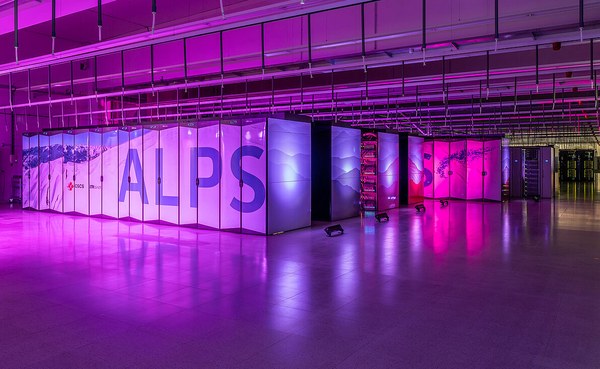11.08.2025
Until recently, simulations of the entire Earth system, including the energy, water, and carbon cycles, at a resolution of one kilometer and over several decades were considered impossible. The number of relevant processes was deemed too large, their interactions too complex, the time scales too long, and the necessary computing power too high. A team lead by the Max Planck Institute for Meteorology (MPI-M) and the German Climate Computing Center (DKRZ) developed a configuration of the ICON model capable of handling this task. By running this setup on the newest supercomputers, the team demonstrated that simulations of the Earth system with a resolution of 1.25 kilometers can indeed be performed, even including the full carbon cycle, and with a throughput that enables studying multi-decadal climate change. In recognition of their accomplishment, they have been nominated for the prestigious Gordon Bell Prize for Climate Modelling.
ICON simulations on Alps and JUPITER
“Being nominated for this important award is a great recognition of our achievements,” says Daniel Klocke, group leader at the MPI-M and first author of the paper describing the high-resolution ICON simulation of the Earth system. In April, the researchers used 8,000 high-performance processors combining central processing units (CPUs) and graphics processing units (GPUs) on the Alps supercomputer at the Swiss National Supercomputing Centre (CSCS), the most powerful European computer at the time, to produce the simulations.
Foto: Supercomputer "Alps" at the CSCS (Credit: CC BY-SA 3.0 CSCS, cropped)
“Our experiments show that we can simulate up to 82.5 days per day on 8,000 of NVIDIA’s GH200 superchips with our comprehensive high-resolution ICON configuration,” says Klocke. “That is fast enough for climate studies over periods of decades.” This ICON configuration is currently being prepared for the JUPITER high-performance computer at the Jülich Research Center and will be one of the first applications on what has since become Europe’s largest supercomputer.
Technical optimization
To technically enable these simulations, Claudia Frauen and Jan Frederik Engels at DKRZ developed a novel approach to exploit the heterogeneity of the Earth system to enable the full use of the heterogeneity of the latest generation of supercomputers. This type of optimization not only allowed for unprecedented throughput, but as Engels points out, it also “saves more than a factor of 3 in energy when we compare our setup to the approaches used by other coupled climate models.”
Earth system models consist of different component models that exhibit very different computational characteristics and are often only loosely coupled. This allows to fully utilize the NVIDIA GH200 nodes of Alps and JUPITER, which consist of both powerful GPUs and CPUs, by computing the different components on the hardware that they are most suited for. Hence, the atmosphere and land components are computed on the GPUs, while the ocean, sea ice, and biogeochemistry components are computed on the CPUs of the same nodes, which otherwise would be mostly idle.
Further optimization was realized in collaboration with computer scientists at ETH Zurich, who introduced Data Centric Parallel Programming concepts to optimize specific components for specific hardware. Together with colleagues from NVIDIA, the Jülich Supercomputing Centre and the CSCS, the team optimized the implementation of ICON on Europe’s newest and most ambitious computing systems.
From afternoon thunderstorms to plant growth
The configuration includes all important Earth system components—the atmosphere, the ocean, the land, and sea ice—as well as the entire carbon cycle, all at a resolution of 1.25 kilometers. “On small scales we have fast interactions between water and energy—for example, when the land surface heats up during the day leading to thunderstorms in the afternoon,” explains MPI-M group leader Cathy Hohenegger, who is the scientific lead. “These thunderstorms bring short, localized and intense rainfall to the plants and now we can see how this projects on the carbon cycle.” The efficiency of the ICON model when using current high-performance computing (HPC) systems shows that it is generally possible to produce such simulations for different future scenarios. These would provide important information for planning local climate adaptation strategies.
Destination Earth digital twin
Other ICON simulations, some of which were created on the Finnish supercomputer LUMI, contributed to another project that was also recognized as finalist for the Gordon Bell Prize for Climate Modelling as part of Destination Earth. The project, to which MPI-M and DKRZ contribute with ICON, is led by the CSC – IT Center for Science in Finland and also includes the Integrated Forecasting System of the European Centre for Medium-Range Weather Forecasts (ECMWF) coupled to the FESOM and NEMO ocean models in two different configurations. Destination Earth develops digital replicas of the Earth system. Nominated for the award is the digital twin for climate change adaptation, which makes climate information directly accessible to users.
The American Association for Computing Machinery awards the Gordon Bell Prize, worth US$10,000, annually for outstanding achievements in HPC. Since 2023, the additional award category “Climate Modelling” has recognized innovations that advance the understanding of the climate system and climate change. The finalists are invited to publish an article describing their technical and scientific achievements in the International Journal of High Performance Computing Applications. The award will be presented in November 2025 in St. Louis, Missouri, during the SC conference (International Conference for High Performance Computing, Networking, Storage, and Analysis), the world's most important HPC meeting.
Further Information
Gordon Bell Prize for Climate Modelling
Contact
Dr. Cathy Hohenegger
Max Planck Institute for Meteorology
Y2F0aHkuaG9oZW5lZ2dlckBtcGltZXQubXBnLmRl
Dr. Daniel Klocke
Max Planck Institute for Meteorology
ZGFuaWVsLmtsb2NrZUBtcGltZXQubXBnLmRl
Dr. Jan Frederik Engels
German Climate Computing Center (DKRZ)
ZW5nZWxzQGRrcnouZGU=
Dr. Claudia Frauen
German Climate Computing Center (DKRZ)
ZnJhdWVuQGRrcnouZGU=
